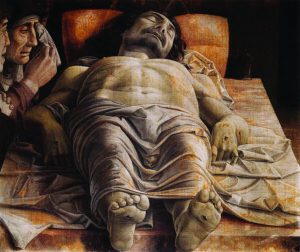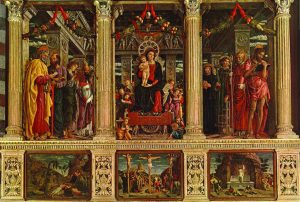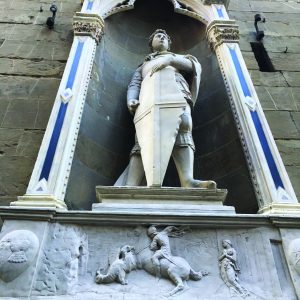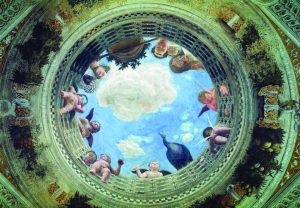He was one of the genius artists of the 1400s and a spectacular example of the Renaissance man.

Andrea Mantegna (1436-1506) is one of the greats in art from the 1400s. Why? Because he was a true master of disegno, both in the literal translation of the word and in the deeper, more complex, definition that the word took on in the early Renaissance period.
Disegno means drawing in English and Mantegna was an excellent draughtsman. This skill is the fundamental tool of any of the three major arts (painting, architecture and sculpture) and it is what all apprentices from the Renaissance onwards spent years doing: copying the drawings and works of their master and drawing the classical statues in order to provide the structure and bases for their own work.
Disegno began to be used in the Renaissance period, however, as the expression of an artist’s skill in the conception or invention of the idea behind the pictorial or sculptural form. So it become a synonym for the artist’s ingenuity and innovation. Mantegna was much acclaimed in his lifetime for his disegno in both these senses.
FExposure to two artistic workshops in his formative years was to shape Mantegna’s life and work. He joined the workshop of Francesco Squarcione in Padua when he was 11 years old. Squarcione was passionate about the Classical world and had amassed a large collection of classical artefacts, as well as many drawings of the classical ruins, as records of his travels to Rome
and (possibly) Greece.
He is remembered today not so much for his artistic production but for the training school for young artists that his workshop became. A source from the 16th century wrote that some 130 students passed through it. Mantegna stayed with Squarcione until he was 17 – he even learned Latin in the workshop.

Mantegna incorporated the classical world into his work with an acute precision, comparative only to miniaturist work. If depicting a Roman scene for example, the architecture would not only be realistically shown but the figures would have appropriate period clothing and accessories. His festoons and garlands, inspired from classical art, look straight from the florist, so vibrant and alive do they seem. They, the wooden frame and the architectural elements, were all placed so that together they created a unitary and highly realistic spatial environment that few before him had achieved so harmoniously. The San Zeno altarpiece (1457-60), one of his masterpieces, for the San Zeno basilica in Verona is a stunning example of this.
The other formative figure in Mantegna’s youth was Donatello, who spent ten years living in Padua (1443-53) working on a series of commissions, nearly all bronze work. Donatello was the superhero of the early Renaissance and was often referred to as the first renaissance sculptor. Donatello was the first to fully transmit, with a tour de force unprecedented since Antiquity, the psychological presence and soul of the figure through his art.

He also was a master of mathematical perspective. His first example of perspective, invented by one of his closest friends, Filippo Brunelleschi, was his bas-relief of Saint George and the Dragon (1416) below his statue of Saint George on the exterior of Orsanmichele church in Florence. Donatello’s combination of the power and nobility of the figure, integrated within a precise realistic space, was hugely influential in the style of Mantegna – indeed, critics have often remarked that Mantegna is ‘Donatello in sculpture’.
Mantegna was innovative and he was the first to really explore the artistic potential of perspective, with the ceiling occulus in the Camera picta or Camera degli sposi (1465-74) in the ducal palace of Mantua. In 1460 he moved to Mantua to accept the generous stipend offered by Marquis Ludovico III Gonzaga and his wife Barbara of Brandenburg. He was the court painter of this enlightened humanist court until his death, and was buried here in 1506.

He frescoed all the walls and ceiling of this room. It immediately became famous and is today one of the iconic renaissance images of the century. He frescoed an occulus, a circular opening, in the centre of the ceiling with the architecture shown in perfect foreshortening, together with an army of delightful putti (little winged male babies present in the Classical era and resurrected in the Renaissance), some looking down from the opening to the people in the room below, others playing – and one that looks like he is about to pee on our heads.
This illusionistic perspective would be all the rage in the 1600s for ceilings in palatial residences and churches, and it appeared first here with Mantegna in the mid-1400s. This spatial illusionistic technique of an opening up to the sky is referred to as di sotto in sù (seen from below), this being the first example.
Another of the most iconic images of the 1400s Renaissance is his Lamentation of the Dead Christ painting, thought to have been painted in the 1480s. This painting was the only one found in his workshop, other than the one that he was working on at the time – and as there are no existing documents referring to this painting (it has been thought that Mantegna meant to keep it for himself).
Mantegna has stripped the scene of pretty much everything except Christ himself, who has just been taken down from the Cross. Present, as always in this scene, are the Virgin Mary and Saint John the Evangelist, devastated in their grief. There is also a face in the top left corner who is most likely Mary Magdalen because there is her perfumed body depicted to the right of Christ’s head. He is lying on the marble slab with his head on a cushion covered with expensive silk, the only sign of wealth for the King of Kings.
The painting was symbolically executed devoid of colour to underline the loss. The extreme foreshortening that Mantegna uses was a complete novelty and was used not just to show off his virtuosity but also to place the viewer in the scene, at the feet of Christ. There is no filter with this painting: it is raw, immediate – and this was the painter’s intention. The viewer is to be confronted with the humanity of Christ and his wounds. The perspective has been deliberately distorted so that the viewer can be at the feet but see Christ’s torso and head. If it were done correctly, the feet would be larger and obstructive.
ABOUT THE WRITER: FREYA MIDDLETON is a private tour guide and writer who lives in Florence, Tuscany. You can read her blog online or learn more about her tours at www.freyasflorence.com
